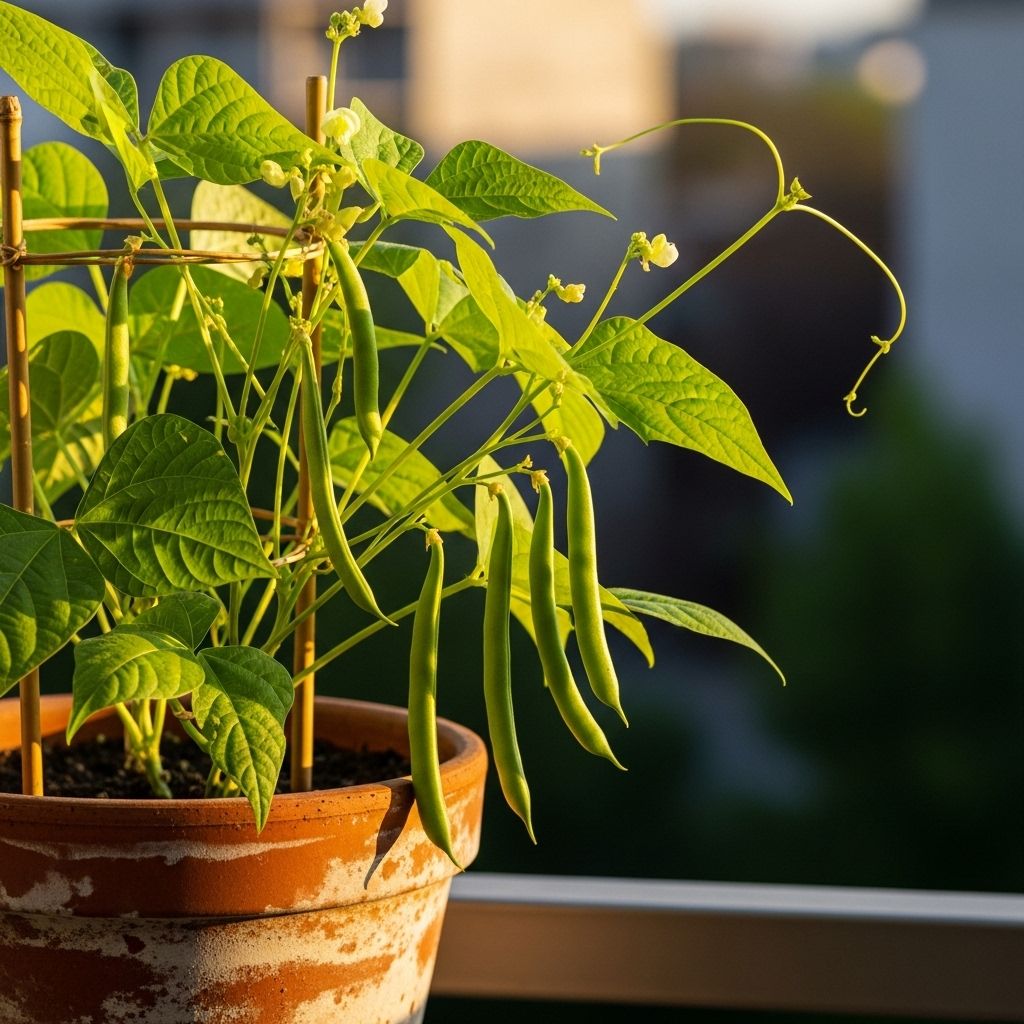Grow Green Beans in Containers: Complete Guide for Small Spaces
Turn any patio or balcony into a thriving bean patch with minimal effort.

How to Grow Green Beans in Pots or Containers
Green beans are among the most beloved garden vegetables, thanks to their crisp flavor and nutritious pods. If you are dealing with limited space, mobility issues, or simply looking for a more manageable gardening approach, growing green beans in containers is an efficient and rewarding way to enjoy a fresh harvest right at home. This guide walks through every crucial step—so you can transform patios, balconies, or sunny corners into productive bean patches.
Why Grow Green Beans in Containers?
- Space-Saving: Perfect solution for those who lack a traditional garden; patios, balconies, or even a sunny window ledge can suffice.
- Mobility: Pots can be moved to better sun or shelter, allowing you to adjust for changing seasons or weather conditions.
- Low Maintenance: Container gardening minimizes weeding, often requires less watering, and can help protect plants from soil-borne pests.
- Root Protection: The roots are shielded from garden soil compaction and some pests, leading to healthier growth and easier troubleshooting.
- Accessibility: Easier for gardeners with limited mobility to plant, water, and harvest.
Choosing the Right Bean Variety
There are two main types of green beans:
- Bush beans: Compact, don’t require trellising, and are highly suited for containers. Examples include ‘Royal Burgundy’, ‘Gold Rush’, and ‘French Filet’.
- Pole beans: Vigorous climbers needing vertical support, good for larger pots with sturdy trellises.
Bush green beans are especially ideal for container gardening in small spaces because they don’t need tall arbors or trellises and mature quickly for continuous harvests.
| Type | Growth Habit | Trellis Needed? | Container Size | Harvest Period |
|---|---|---|---|---|
| Bush | Compact, Upright | No | Small-medium | Short (all at once) |
| Pole | Vining, Tall | Yes | Large, deep | Extended (over weeks) |
Recommended Varieties for Containers
- French Filet Bush Bean: Slender, tender pods, compact at 12-16″ tall, frost sensitive, highly container-compatible.
- Royal Burgundy Bush Bean: Beautiful purple beans that can thrive in pots and mature quickly.
- Gold Rush Bush Bean: Yellow-podded, productive, and compact.
- Trionfo Violetto (Pole): For larger containers and vertical setups.
Selecting the Best Container
Green beans are not heavy feeders but require adequate space for both root development and air circulation. The choice of a container will depend on which type you grow:
- Size: At least 12″ diameter and 8-10″ deep for bush beans; bigger for pole beans to anchor stakes or trellises.
- Drainage: Must have drainage holes to prevent waterlogging and root rot.
- Material: Terra cotta, plastic, fabric pots, or raised planter boxes—all work as long as drainage and volume needs are met.
- Mobility: Consider light-weight containers or those with wheels if you plan to move plants.
Best Potting Mix for Green Beans
- Light and Well-Draining: Green beans dislike soggy soil, so use a potting mix that drains freely and retains enough moisture.
- Nutrient Content: Mix in compost or a slow-release organic fertilizer to supply beans with steady nutrition.
- Soil pH: Slightly acidic to neutral (pH 6.0-7.0).
If reusing containers, sterilize them first to prevent disease carryover.
How to Plant Green Beans in Containers
- Select seeds: Use fresh seeds for strong germination. Avoid transplanting seedlings for beans—they dislike root disturbance.
- Planting Time: Sow directly into containers 1-2 weeks after last frost, when soil temp exceeds 65°F (ideally 70°-85°F).
- Seed Depth: Plant each seed about 1″ deep.
- Spacing: Position seeds every 4″. For bush varieties, no thinning is required. Leave room to allow air flow.
- Water in gently: Ensure even moisture but avoid oversaturation.
Light and Location Requirements
- Sunlight: Place containers in an area receiving at least 6-8 hours of direct sun daily.
- Temperature: Green beans thrive in warm conditions (ideal daytime temps: 70°-85°F). Protect from intense heat or chilly nights.
- Mobility Advantage: Containers let you shift plants for optimum sun exposure and protection from wind or heatwaves.
Watering and Fertilization
- Watering: Check soil daily in hot weather. Water when the mix dries out an inch below surface, but don’t let it get soggy.
- Drainage: Fast-draining pots stop roots from sitting in stagnant moisture, which can lead to fungal issues.
- Feeding: Use organic fertilizer or compost at planting then supplement lightly once beans begin flowering for healthy pods.
- Mulching: Top the soil with a layer of organic mulch to maintain moisture and deter weeds.
Supporting Your Bean Plants
- Bush Beans: Rarely require support, though a small stake can help anchor plants in windy spots.
- Pole Beans: Install a trellis, teepee, or vertical netting at planting; beans will climb as they grow.
Common Pests and Disease Prevention
Container-grown beans are generally less vulnerable to soil-borne issues but watch for these common problems:
- Aphids: Wash off with spray of water or treat with insecticidal soap.
- Spider mites: Increase humidity and inspect undersides of leaves regularly.
- Fungal diseases: Ensure proper drainage and airflow; remove any affected leaves promptly.
- Root rot: Avoid overwatering, and always use a container with drainage holes.
Maintenance Tips for Healthy Growth
- Weed Control: Minimal needed—just pluck any weeds growing in the container by hand.
- Consistent Harvesting: For snap beans, pick pods regularly as they reach full size to encourage more production.
- Monitoring: Watch for yellowing leaves, pest infestations, and signs of water stress.
- Rotate Location: Shift containers seasonally for best sun and to minimize disease buildup.
Harvesting Container-Grown Green Beans
- Harvest timing: Snap beans mature quickly; harvest when pods are firm, bright green, and well-filled but not bulging.
- How to Pick: Snap pods off gently, avoiding damage to the plant.
- Frequency: Harvest every few days during peak production to keep plants productive.
- Post-Harvest: Wash pods gently and store in the refrigerator for up to a week; best texture and flavor are enjoyed within a few days of picking.
Growing Green Beans: Troubleshooting Tips
Are your plants facing challenges? Find solutions below:
- Leaves yellowing: May indicate overwatering, poor drainage, or lack of nitrogen.
- Pods not forming: Beans often drop flowers in prolonged heat above 90°F; provide shade and avoid summer sowing in hot climates.
- Poor growth: Roots may be too crowded; use a larger container or thin seedlings if needed.
- Stunted seedlings: Plant directly in final container; beans do not transplant well due to root sensitivity.
Extending Your Bean Harvest
- Successive sowings: Plant seeds every 7-14 days throughout spring for continuous harvest, stopping about 80 days before first fall frost.
- Companion planting: Green beans grow well with carrots, lettuce, and herbs in shared containers.
Final Thoughts
Whether you’re a beginner gardener or a seasoned pro, growing green beans in containers is practical, convenient, and highly rewarding. With a little planning and care, anyone can enjoy fresh, flavorful beans packed with nutrition. You only need a sunlit spot and a few months of attention to put homegrown vegetables on your table. After mastering beans, you may find yourself adding even more vegetables to your portable patio garden.
Frequently Asked Questions (FAQs)
Q: What type of green beans grows best in containers?
A: Bush beans are most suitable due to their compact growth and lack of need for vertical support. However, pole beans can also be grown successfully with the addition of a trellis.
Q: How often should I water container-grown green beans?
A: Water when the top inch of soil feels dry. Containers generally require more frequent watering, especially in warm weather, but avoid waterlogging.
Q: Can I grow green beans indoors?
A: Yes, if you have a sunny window receiving 6-8 hours of direct sunlight or supplemental grow lights. Opt for smaller bush bean varieties.
Q: When should I start harvesting?
A: Begin harvest when pods are firm, crisp, and well-filled but before seeds bulge. Regular picking encourages more pod production.
Q: What is the minimum container size for green beans?
A: For bush varieties, use pots at least 12″ wide and 8-10″ deep. For pole beans, select larger containers to fit trellises.
Q: Why are my bean plants dropping flowers?
A: This often occurs in temperatures consistently above 90°F. Try providing afternoon shade or sowing beans earlier/later in cooler periods.
Quick Reference Table: Bean Varieties for Containers
| Variety Name | Type | Color | Mature Height | Days to Maturity |
|---|---|---|---|---|
| French Filet | Bush | Green | 12-16″ | 58 |
| Royal Burgundy | Bush | Purple | 14-16″ | 55-60 |
| Gold Rush | Bush | Yellow | 14-18″ | 55 |
| Trionfo Violetto | Pole | Purple | 6+ ft (trellised) | 60-70 |
Resources & Inspiration
- Check with your local nursery for recommended bean varieties and organically sourced potting mixes suitable for your climate.
- For vertical gardening, modular stacked containers can increase yield in tiny spaces.
- Join gardening forums or groups like Epic Gardening for support, troubleshooting, and inspiration.
References
Read full bio of Shinta












